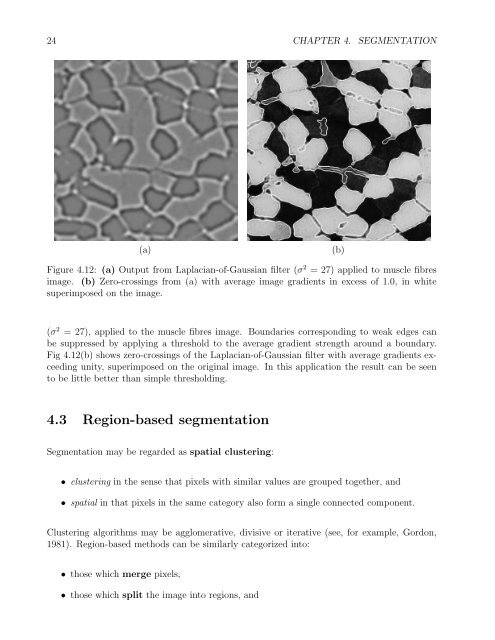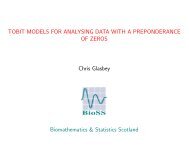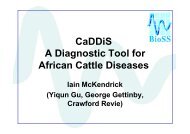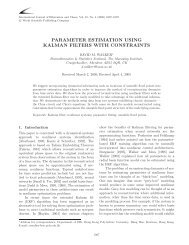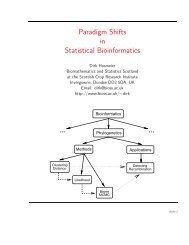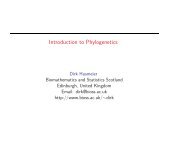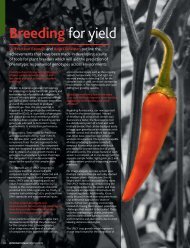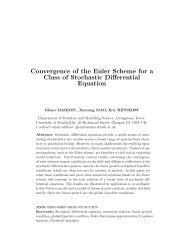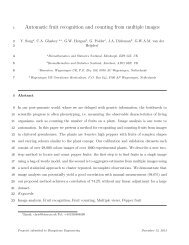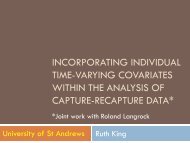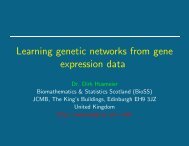24 CHAPTER 4. <strong>SEGMENTATION</strong>(a)(b)Figure 4.12: (a) Output from Laplacian-of-Gaussian filter (σ 2 = 27) applied to muscle fibresimage. (b) Zero-crossings from (a) with average image gradients in excess of 1.0, in whitesuperimposed on the image.(σ 2 = 27), applied to the muscle fibres image. Boundaries corresponding to weak edges canbe suppressed by applying a threshold to the average gradient strength around a boundary.Fig 4.12(b) shows zero-crossings of the Laplacian-of-Gaussian filter with average gradients exceedingunity, superimposed on the original image. In this application the result can be seento be little better than simple thresholding.4.3 Region-based segmentationSegmentation may be regarded as spatial clustering:• clustering in the sense that pixels with similar values are grouped together, and• spatial in that pixels in the same category also form a single connected component.Clustering algorithms may be agglomerative, divisive or iterative (see, for example, Gordon,1981). Region-based methods can be similarly categorized into:• those which merge pixels,• those which split the image into regions, and
4.3. REGION-BASED <strong>SEGMENTATION</strong> 25• those which both split-and-merge in an iterative search scheme.The distinction between edge-based and region-based methods is a little arbitrary. For example,in §4.2 one of the algorithms we considered involved placing all neighbouring non-edge pixelsin the same category. In essence, this is a merging algorithm.Seeded region growing is a semi-automatic method of the merge type. We will explain it byway of an example. Fig 4.13(a) shows a set of seeds, white discs of radius 3, which have beenplaced inside all the muscle fibres, using an on-screen cursor controlled by a computer mouse.Fig 4.13(b) shows again the output from Prewitt’s edge filter. Superimposed on it in white arethe seeds and the boundaries of a segmentation produced by a form of watershed algorithm.The boundaries are also shown superimposed on the original muscle fibres image in Fig 4.13(c).The watershed algorithm operates as follows (we will explain the name later).For each of a sequence of increasing values of a threshold, all pixels with edge strength lessthan this threshold which form a connected region with one of the seeds are allocated to thecorresponding fibre. When a threshold is reached for which two seeds become connected, thepixels are used to label the boundary. A mathematical representation of the algorithm is toocomplicated to be given here. Instead, we refer the reader to Vincent and Soille (1991) formore details and an efficient algorithm. Meyer and Beucher (1990) also consider the watershedalgorithm, and added some refinements to the method.Note that:• The use of discs of radius 3 pixels, rather than single points, as seeds make the watershedresults less sensitive to fluctuations in Prewitt’s filter output in the middle of fibres.• The results produced by this semi-automatic segmentation algorithm are almost as goodas those shown in Fig 4.10(b), but the effort required in positioning seeds inside musclefibres is far less than that required to draw boundaries.• Adams and Bischof (1994) present a similar seeded region growing algorithm, but baseddirectly on the image greyscale, not on the output from an edge filter.Th watershed algorithm, in its standard use, is fully automatic. Again, we will demonstrate thisby illustration. Fig 4.14 shows the output produced by a variance filter (§3.4.1) with Gaussianweights (σ 2 = 96) applied to the muscle fibres image after histogram-equalization (as shownin Fig 2.7(d)). The white seeds overlie all the local minima of the filter output, that is, pixelswhose neighbours all have larger values and so are shaded lighter. Note that it is necessary touse a large value of σ 2 to ensure that the filter output does not have many more local minima.The boundaries produced by the watershed algorithm have been added to Fig 4.14. An intuitiveway of viewing the watershed algorithm is by considering the output from the variance filter asan elevation map: light areas are high ridges and dark areas are valleys (as in Fig 1.5). Eachlocal minimum can be thought of as the point to which any water falling on the region drains,and the segments are the catchments for them. Hence, the boundaries, or watersheds, lie alongtops of ridges. The previously mentioned Fig 4.1(c) shows this segmentation superimposed onthe original image.


